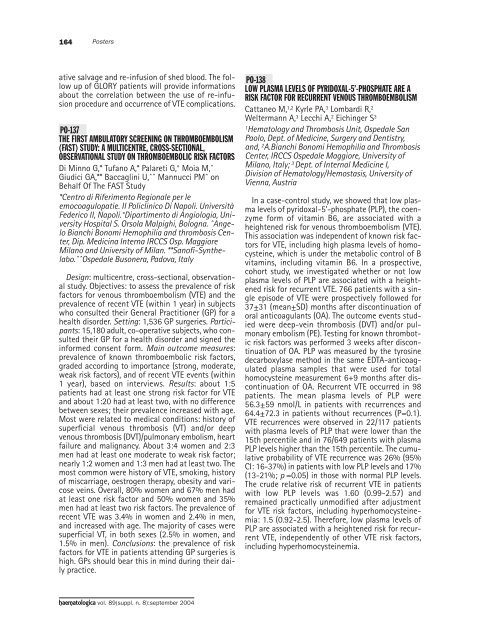Haematologica 2004;89: supplement no. 8 - Supplements ...
Haematologica 2004;89: supplement no. 8 - Supplements ...
Haematologica 2004;89: supplement no. 8 - Supplements ...
- No tags were found...
You also want an ePaper? Increase the reach of your titles
YUMPU automatically turns print PDFs into web optimized ePapers that Google loves.
164Postersative salvage and re-infusion of shed blood. The followup of GLORY patients will provide informationsabout the correlation between the use of re-infusionprocedure and occurrence of VTE complications.PO-137THE FIRST AMBULATORY SCREENING ON THROMBOEMBOLISM(FAST) STUDY: A MULTICENTRE, CROSS-SECTIONAL,OBSERVATIONAL STUDY ON THROMBOEMBOLIC RISK FACTORSDi Min<strong>no</strong> G,* Tufa<strong>no</strong> A,* Palareti G,° Moia M,^Giudici GA,** Baccaglini U,^^ Mannucci PM^ onBehalf Of The FAST Study*Centro di Riferimento Regionale per leemocoagulopatie. II Policlinico Di Napoli. UniversitàFederico II, Napoli.°Dipartimento di Angiologia, UniversityHospital S. Orsola Malpighi, Bologna. ^AngeloBianchi Bo<strong>no</strong>mi Hemophilia and thrombosis Center,Dip. Medicina Interna IRCCS Osp. MaggioreMila<strong>no</strong> and University of Milan. **Sa<strong>no</strong>fi-Synthelabo.^^OspedaleBusonera, Padova, ItalyDesign: multicentre, cross-sectional, observationalstudy. Objectives: to assess the prevalence of riskfactors for ve<strong>no</strong>us thromboembolism (VTE) and theprevalence of recent VTE (within 1 year) in subjectswho consulted their General Practitioner (GP) for ahealth disorder. Setting: 1,536 GP surgeries. Participants:15,180 adult, co-operative subjects, who consultedtheir GP for a health disorder and signed theinformed consent form. Main outcome measures:prevalence of k<strong>no</strong>wn thromboembolic risk factors,graded according to importance (strong, moderate,weak risk factors), and of recent VTE events (within1 year), based on interviews. Results: about 1:5patients had at least one strong risk factor for VTEand about 1:20 had at least two, with <strong>no</strong> differencebetween sexes; their prevalence increased with age.Most were related to medical conditions: history ofsuperficial ve<strong>no</strong>us thrombosis (VT) and/or deepve<strong>no</strong>us thrombosis (DVT)/pulmonary embolism, heartfailure and malignancy. About 3:4 women and 2:3men had at least one moderate to weak risk factor;nearly 1:2 women and 1:3 men had at least two. Themost common were history of VTE, smoking, historyof miscarriage, oestrogen therapy, obesity and varicoseveins. Overall, 80% women and 67% men hadat least one risk factor and 50% women and 35%men had at least two risk factors. The prevalence ofrecent VTE was 3.4% in women and 2.4% in men,and increased with age. The majority of cases weresuperficial VT, in both sexes (2.5% in women, and1.5% in men). Conclusions: the prevalence of riskfactors for VTE in patients attending GP surgeries ishigh. GPs should bear this in mind during their dailypractice.PO-138LOW PLASMA LEVELS OF PYRIDOXAL-5’-PHOSPHATE ARE ARISK FACTOR FOR RECURRENT VENOUS THROMBOEMBOLISMCattaneo M, 1,2 Kyrle PA, 3 Lombardi R, 2Weltermann A, 3 Lecchi A, 2 Eichinger S 31Hematology and Thrombosis Unit, Ospedale SanPaolo, Dept. of Medicine, Surgery and Dentistry,and, 2 A.Bianchi Bo<strong>no</strong>mi Hemophilia and ThrombosisCenter, IRCCS Ospedale Maggiore, University ofMila<strong>no</strong>, Italy; 3 Dept. of Internal Medicine I,Division of Hematology/Hemostasis, University ofVienna, AustriaIn a case-control study, we showed that low plasmalevels of pyridoxal-5’-phosphate (PLP), the coenzymeform of vitamin B6, are associated with aheightened risk for ve<strong>no</strong>us thromboembolism (VTE).This association was independent of k<strong>no</strong>wn risk factorsfor VTE, including high plasma levels of homocysteine,which is under the metabolic control of Bvitamins, including vitamin B6. In a prospective,cohort study, we investigated whether or <strong>no</strong>t lowplasma levels of PLP are associated with a heightenedrisk for recurrent VTE. 766 patients with a singleepisode of VTE were prospectively followed for37±31 (mean±SD) months after discontinuation oforal anticoagulants (OA). The outcome events studiedwere deep-vein thrombosis (DVT) and/or pulmonaryembolism (PE). Testing for k<strong>no</strong>wn thromboticrisk factors was performed 3 weeks after discontinuatio<strong>no</strong>f OA. PLP was measured by the tyrosinedecarboxylase method in the same EDTA-anticoagulatedplasma samples that were used for totalhomocysteine measurement 6+9 months after discontinuatio<strong>no</strong>f OA. Recurrent VTE occurred in 98patients. The mean plasma levels of PLP were56.3±59 nmol/L in patients with recurrences and64.4±72.3 in patients without recurrences (P=0.1).VTE recurrences were observed in 22/117 patientswith plasma levels of PLP that were lower than the15th percentile and in 76/649 patients with plasmaPLP levels higher than the 15th percentile. The cumulativeprobability of VTE recurrence was 26% (95%CI: 16-37%) in patients with low PLP levels and 17%(13-21%; p =0.05) in those with <strong>no</strong>rmal PLP levels.The crude relative risk of recurrent VTE in patientswith low PLP levels was 1.60 (0.99-2.57) andremained practically unmodified after adjustmentfor VTE risk factors, including hyperhomocysteinemia:1.5 (0.92-2.5). Therefore, low plasma levels ofPLP are associated with a heightened risk for recurrentVTE, independently of other VTE risk factors,including hyperhomocysteinemia.haematologica vol. <strong>89</strong>(suppl. n. 8):september <strong>2004</strong>
















